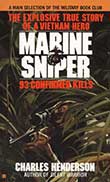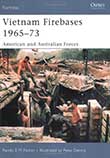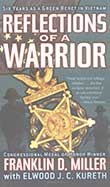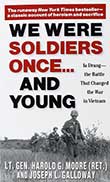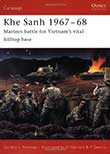

Sometimes truth really is stranger than fiction. The life of Carlos N. Hathcock II reads like the plot summary of a summer block buster movie. Hathcock resurrected the shunned and despised art of sniping and held off an entire company of enemy soldiers for five days with only the assistance of his spotter. He infiltrated deep behind enemy lines to assassinate an enemy commander with a single shot and then escaped undetected. Later, he sacrificed his life and body to save his fellow soldiers. He was feared and respected by his comrades and adversaries alike, he never gave up and fought incredible odds time and again and each time surmounted them.
The events are all true, despite the sensational sound of them. Marine Sniper: 93 Confirmed Kills is a biography of a two times Vietnam War veteran who, despite the extraordinary and dangerous path his life took, didn’t succumb to gun fire, mines, bombs or knives. In the end, frustrated at a body that could no longer do the things he loved to do, confined to wheelchairs and hospital beds, Carlos Hathcock died of multiple sclerosis twenty years after he was unable to serve his country as a Marine any more, and after twenty years of distinguished service.
Marine Sniper: 93 Confirmed Kills follows Hathcock’s life from his enrolment in to the Marine Corps at the age of 17 through to a little after his forced retirement at the age of 37. For the most part, it is an enjoyable read and, although biographical, still manages to incorporate large doses of suspense and conflict.
Impressive in terms of scale and structure, the Fire Support Base became a dominant element in ground maneuver during the Vietnam War. Initially a mobile base, it soon evolved into a semi-permanent and more sophisticated fortress as a result of enemy counterattacks and bombardments.
As a consequence, the majority of US and other allied troops found themselves pinned down in defensive or support roles, rather than being free to conduct 'search and destroy' or other mobile missions. Thus, the first and foremost function of the Fire Support Base was defensive. Troops, machine guns, mortars, artillery, surveillance radars, and command centers all had to be dug into bunkers and fire trenches by nightfall of the first day. Around these positions there would be deep belts of barbed wire, generously scattered with several different types of mines and even, in a few cases after 1967, with a brand new series of electronic sensors to detect and locate the enemy at a distance.
With the benefit of the on-site howitzers, the FSB could also deliver offensive high volume fire, reaching as far as 14,600m and eliminating enemy firing sites, supporting friendly infantry operations, or simply participating in fire missions where exact targets were not known. In fact, the fort offered such a degree of support and protection that ground maneuver was eventually hampered by the troop's reluctance to leave the comfort and safety of the FSB.
With a description of the design, development and operational history of the Fire Support Base, this book provides the key to understanding one of the main assets of US battle strategy in the Vietnam War.
PFC Franklin Miller arrived in Vietnam in March 1966, and saw his first combat in a Reconnaissance Platoon. So began an odyssey that would make him into one of the most feared and respected men in the Special Forces elite, who made their own rules in the chaos of war.
In the exclusive world of the Military Assistance Command, Vietnam, Studies and Observation Group, Miller ran missions deep into enemy territory to gather intelligence, snatch prisoners, and to kill. Leading small bands of battle-hardened Montagnard and Meo tribesmen, he was fierce and fearless -- fighting army policy to stay in combat for six tours. On a top-secret mission in 1970, Miller and a handful of men, all critically injured, held off the NVA in an incredible Alamo-like stand -- for which he was awarded the Congressional Medal of Honor. When his time in Southeast Asia ended, he had also received the Silver Star, two Bronze Stars, an Air Medal, and six Purple Hearts. This is his incredible story.
Each year, the Commandant of the U.S. Marine Corps selects one book that he believes is both relevant and timeless for reading by all Marines. The Commandant's choice for 1993 was We Were Soldiers Once . . . and Young.
In November 1965, some 450 men of the 1st Battalion, 7th Cavalry, under the command of Lt. Col. Hal Moore, were dropped by helicopter into a small clearing in the Ia Drang Valley. They were immediately surrounded by 2,000 North Vietnamese soldiers. Three days later, only two and a half miles away, a sister battalion was chopped to pieces. Together, these actions at the landing zones X-Ray and Albany constituted one of the most savage and significant battles of the Vietnam War.
How these men persevered—sacrificed themselves for their comrades and never gave up—makes a vivid portrait of war at its most inspiring and devastating.
General Moore and Joseph Galloway, the only journalist on the ground throughout the fighting, have interviewed hundreds of men who fought there, including the North Vietnamese commanders. This devastating account rises above the specific ordeal it chronicles to present a picture of men facing the ultimate challenge, dealing with it in ways they would have found unimaginable only a few hours earlier. It reveals to us, as rarely before, man's most heroic and horrendous endeavor.
Khe Sanh was a small village in northwest South Vietnam that sat astride key North Vietnamese infiltration routes. In September 1966 of the Vietnam War (1955-1975), a Marine battalion deployed into the area. Action gradually increased as the NVA attempted to destroy Free World Forces bases, and the siege of Khe Sanh proper began in October 1967. The bitter fight lasted into July 1968 when, with the changing strategic and tactical situation, the base was finally closed. This book details the siege and explains how, although the NVA successfully overran a Special Forces camp nearby, it was unable to drive US forces from Khe Sanh.
Pope Stefanus II arrives in Ponthion
Afonso IV succeeds Dionysius as King of Portugal
Calais, last English possession in France, retaken by French
Antonio "Michele" Ghislieri is elected Pope Pius V
Michaele Ghislieri is elected Pope Pius V
England signs an offensive and defensive alliance with Netherland
Last day of the Julian calendar in Bohemia and Holy Roman empire
Boris Godunov seizes Russian throne on death of Feodore I
Robert, Earl of Essex leads revolt in London against Queen Elizabeth
Fire destroys Jamestown, Virginia
Galileo discovers 1st 3 Jupiter satellites, Io, Europa and Ganymede
Francis Bacon becomes English lord chancellor
Germany and Transylvania sign Peace of Nikolsburg
Composer Pier Cavalli marries rich widow Maria Sosomeno
Fire after heavy storm destroys 2 / 3 of De Rijp Neth, 1 dies
Russian Czar Peter the Great departs Netherlands to England
Typewriter patented by Englishman Henry Mill (built years later)
Battle at Panipat India: Afghan army beats Mahratten
1st US commercial bank, Bank of North America, opens in Philadelphia
1st US seed business established by David Landreth, Philadelphia
1st balloon flight across English Channel (Blanchard & Jeffries)
2nd Bank of US opens
1st printing in Hawaii
Liberia colonized by Americans
1st US Railroad Station opens (Baltimore)
HMS Beagle anchors off Chonos Archipelago
Florida troops takeover Ft Marion at St. Augustine
Battle of Manassas Junction, Virginia
Romney Campaign-Stonewall Jackson march towards Romney, West Virginia
Arkansas constitutional convention meets in Little Rock
Mississippi constitutional convention meets in Jackson
Dutch King Willem II marries Emma von Waldeck-Pyrmont
Start of Sherlock Holmes adventure "Valley of Fear" (BG)
W B Purvis patents fountain pen
Mine explosion kills 100, Krebs, Okla-blacks trying to help rescue white survivors, driven away with guns
Hermann Sudermanns "Heimat, " premieres in Berlin
Motion picture experiment of comedian Fred Ott filmed sneezing
Fanny Farmer publishes her 1st cookbook
Start of Sherlock Holmes "Adventure of Blanched Soldier" (BG)
Marconi Co establishes "CQD" as 1st International radio distress signal
England beat Australia by one wicket at the MCG
Stanley Cup: Ottawa Senators sweep Galt (Ont) in 2 games
1st airplane bombing experiments with explosives, San Francisco
Dutch Scouts Organization established in Amsterdam
William M Burton patents a process to "crack" petroleum
1st steamboat passes through Panama Canal
German troops conquer Fort Vaux at Verdun
Baltimore Sun warns of Ku Klux Klan
Musical "Big Boy" with Al Jolson premieres in New York City
Coml transatlantic telephone service inaugurated between New York and London
Harlem Globetrotters play 1st game (Hinckley, Ill)
"Buck Rogers, " 1st sci-fi comic strip, premieres
"Tarzan, " one of the 1st adventure comic strips, 1st appears
1st telephone connection between Netherlands and East Indies
1st game played at Orchard Lake Curling Club, Michigan
1st edition of People and Fatherland published in the Netherlands
"Flash Gordon" comic strip (by Alex Raymond) debuts
Princess Juliana marries German Prince Bernhard von Lippe-Biesterfeld
Tennis champs Helen Moody and Howard Kinsley volley 2,001 times (1h18m)
WW II siege of Bataan starts
Air Force announces production of 1st US jet fighter, the Bell P-59
Lord Haw-Haw reports total German victory at Ardennen
Cambodia becomes autonomous state inside French Union
US President Truman raises taxes for Marshall-plan
1st photo of genes taken at University of Southern California by Pease and Baker
"Happy as Larry" closes at Coronet Theater NYC after 3 performances
Mental health wing of Mercy Hospital burns, kills 41 (Davenport Ia)
French Plevin government falls
President Truman announces development of hydrogen bomb
Marian Anderson becomes 1st black singer to perform at Met (NYC)
WCIQ TV channel 7 in Mt Cheaha, AL (PBS) begins broadcasting
Vinoo Mankad scores 231 vs. New Zealand, 413 opening stand with Roy
USSR shrinks army to 300,000
1st NFL Playoff Bowl (runner-up bowl) - Detroit beats Cleveland 17-16
Trucial States (now UAE) issue their 1st postage stamps
AFL Pro Bowl: West beats East 47-27
Assassination attempt on Indonesian President Sukarno, fails
Bollingen Prize for poetry awarded to John Hall Wheelock
1st class postage raised from 4 cents to 5 cents
Bahamas becomes self-governing
Dick Weber rolls highest bowling game in air (Boeing 707)
France announces it will convert $150 million of its currency to gold
Dance Theatre of Harlem debuts
Gene Kiniski beats Lou Thesz in St. Louis, to become NWA champ
"Newlywed Game" premieres on ABC TV
"GE College Bowl" quiz show premieres on NBC TV
1st class postage raised from 5 cents to 6 cents
US Congress doubles President salary
Farmers sue Max Yasgur for $35,000 in damages caused by "Woodstock"
LA Lakers chalk up 33rd consecutive win (NBA record)
Lewis F Powell Jr becomes a Supreme Court Justice
William Hubbs Rehnquist, sworn in as Supreme Court Justice
"Purlie" closes at Billy Rose Theater NYC after 14 performances
British Darts Organisation founded in North London
Johnny Watkins bowls six overs 0-21 vs. Pakistan Never again
US Poet James Merrill wins Bollingen Prize
WNPB TV channel 13 in Marquette, MI (PBS) begins broadcasting
Dutch rations gasoline
"Shenandoah" opens at Alvin Theater NYC for 1050 performances
Bollingen Prize for poetry awarded to AR Ammons (Sphere)
Led Zeppelin fans riot before Boston concert, causing $30,000 damage
Angola revises its constitution
Vietnamese forces capture Phnom Penh from Khmer Rouge
"Fame" premieres on NBC TV
Australia regain the Ashes with a 2-1 series win vs. England
Reagan ends US arms embargo against Guatemala
"King & I" opens at Broadway Theater NYC for 191 performances
KHQ-AM in Spokane WA changes call letters to KLSN (now KAQQ)
Chicago Bears defeat New England Patriots 46-10 in Super Bowl XX
Netherlands Bank issues 250 guilder notes
STS 61-C mission scrubbed at T -9m because of weather problems
US President Reagan proclaims economic sanctions against Libya
French airplanes harass Libyan positions in Duadi Doum
Kapil Dev takes his 300th Test wicket, at 28 the youngest
Akhito becomes Emperor of Japan
Cleveland Cavs block 21 New York Knick shots tying NBA regulation game record
International Conference on Limitation of Chemical Weapons opens in Paris
Lynn Jennings runs world record 5K indoor at 15:22.64
Tower Of Pisa closed to the public after leaning too far
"Nia Peeples Party Machine" premieres on TV
AT&T releases video-telephone ($1,499)
South Africa beat Australia in the Sydney Test by 5 runs
United Express commuter plane crashes in Ohio, killing 5
US female Figure Skating championship won by Tonya Harding
"Christmas Carol" closes at Richard Rodgers Theater NYC after 18 performances
"Passion" closes at Plymouth Theater NYC after 280 performances
"Crazy after You" closes at Shubert Theater NYC after 1622 performances
16th United Negro College Fund raises $12,600,000
Newt Gingrich, narrowly re-elected speaker of the House
